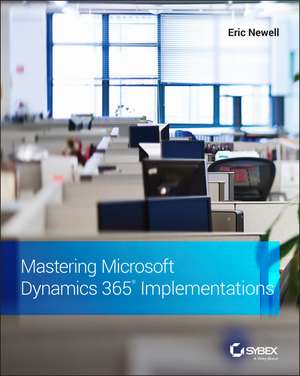Mastering Microsoft Dynamics 365 Implementations
Autor E Newellen Limba Engleză Paperback – 4 iul 2021
Preț: 291.22 lei
Nou
Puncte Express: 437
Preț estimativ în valută:
55.73€ • 57.97$ • 46.01£
55.73€ • 57.97$ • 46.01£
Carte disponibilă
Livrare economică 24 martie-07 aprilie
Preluare comenzi: 021 569.72.76
Specificații
ISBN-13: 9781119789321
ISBN-10: 111978932X
Pagini: 416
Dimensiuni: 190 x 237 x 20 mm
Greutate: 0.68 kg
Editura: Sybex
Locul publicării:Hoboken, United States
ISBN-10: 111978932X
Pagini: 416
Dimensiuni: 190 x 237 x 20 mm
Greutate: 0.68 kg
Editura: Sybex
Locul publicării:Hoboken, United States
Notă biografică
Eric Newell is the Co-Founder and CEO of Stoneridge Software, a Microsoft Gold Partner, focused on Dynamics. Prior to founding Stoneridge, he worked at Microsoft for 13 years in Dynamics-related roles including support engineer, IT lead for support systems, Technical Account Manager and as a Premier Field Engineering team leader. He frequently presents on topics related to implementing Microsoft Dynamics 365, and has spoken at Microsoft conferences over a dozen times. He has served as a project management trainer at Microsoft as well as local universities.
Cuprins
Introduction xxvii
Chapter 1 * Stages of an Implementation Overview 1
What Is Microsoft Dynamics? 1
The Client Journey 2
Implementation Methodologies 5
Waterfall and Sure Step 5
Agile and Scrum 7
Triple Constraints 8
The Bottom Line 9
Chapter 2 * What to Do Before You Begin a Project 11
Identify Your Project Team and Stakeholders 11
Executive Sponsor 12
Project Owner 12
Business Process Owner(s) 13
Project Manager 13
Core Team and a Core Team Lead 14
Subject Matter Experts 14
IT Resources 15
Time Commitment by Role 17
Identify Your Processes in Scope 18
Clean Up Your Data 19
Identify Your "Master" Data 19
Develop Naming Conventions 20
Identify System Owners 20
Find and Resolve Duplicates and Incorrect Data 20
Define Your Success Metrics 21
Possible Benefits 22
Building Your Business Case and Securing Funding 23
How Much Should an ERP Project Cost? 24
Costs to Include in Your Calculations 24
Capitalizing Costs 25
Contingency 27
Return on Investment (ROI) 27
Gaining Approval 28
The Bottom Line 29
Chapter 3 * Four Keys to Consider When Buying an ERP or CRM Solution 31
Selection Process 31
Selection Consultant 32
Decision Maker 33
The Four Keys 33
Fit 34
Platform 35
Implementer 39
Cost 41
Building Your Scorecard 44
The Bottom Line 45
Chapter 4 * How to Evaluate and Buy Business Application Software 47
Buying Process Steps 47
Qualification Stage 48
Discovery and Demonstration Stage 49
Selecting Your Vendor 51
Leadership or Board Approval 54
Moving Forward 54
The Bottom Line 54
Chapter 5 * Organizing Your Team for Success and Project Governance 57
RACI 57
Your Project Team 58
Your Partner's Implementation Team 59
Executive Sponsor 60
Engagement Manager 60
Project Manager 60
Solution Architect or Solution Delivery Manager 60
Functional Consultant or Consultants 61
Technical Consultant 61
Development Lead and Developers 61
Integration Architect 61
Data Migration Specialist 62
Project Governance 62
Project Communication 62
Resource Loading 62
Project Schedule 66
Document Repository 67
Budget Tracking 68
Change Requests 68
Project Management Plan 68
The Bottom Line 69
Chapter 6 * Sprints and Tools Needed to Run Your Project 73
Definition of a Sprint 73
Length of a Sprint 74
Start and End of a Sprint 74
Delivering Value in a Sprint 74
Backlog 75
Project Backlog 75
Sprint Backlog 76
Allocating Work to Team Members 76
Sprint Success Rate 76
Sprint Meetings 77
Sprint Planning 77
Sprint Review 77
Sprint Retrospective 78
Stand-up Meetings 78
Work Definitions 79
Epic 79
Feature 79
User Story 80
Requirement 80
Research Task 80
Design Task 80
Development Task 81
Test Task 81
Other Task 81
Test Case 81
Test 81
Bug (Defect) 81
Risk 81
Issue 82
Change Request 82
Code and Changesets 82
Azure DevOps 82
DevOps Fields 82
Progress Reporting 83
Analytical Views 83
The Bottom Line 84
Chapter 7 * Change Management Throughout Your Project 87
Success Criteria 88
Use of Satisfaction Surveys 89
Nine Steps to Change Management 90
Leadership Alignment 90
Organization Evaluation 91
Outline Your Business Process Change Steps 92
Develop a System Vision that Provides Benefits to All Stakeholders 92
Communicate Effectively 92
Maximize the Team's Time in the New System 94
Train Effectively 94
Set Realistic Expectations for the System Just After Go-Live 94
Support Your Team Members After Go-Live 95
Steps to Business Process Change 95
Importance of Adoption 96
The Bottom Line 96
Chapter 8 * Organizing Your Business by Processes 99
Common Language Businesses Speak 99
Operations 100
Sales 100
Finance and Administration 100
Standard Processes 100
Process Hierarchy 102
Process Category 102
Process Group 103
Process 103
Sub-processes, Tasks, Activities, and Requirements 104
Discovering Your Processes 104
SIPOC 104
Core Team Members 106
Rounding Out Your Scope 106
The Bottom Line 106
Chapter 9 * Independent Software Vendors--Filling Gaps and Managing Partnerships 109
The Purpose of ISVs 109
Hosting Providers 110
Private Hosting 111
SaaS-Style Hosting 111
Industry ISVs 111
Deciding If You Need an Industry ISV 112
Functional ISVs 113
Missing Functionality 113
Advanced Features 113
Missing Connector 113
Automation 114
Reporting Extensions 114
Deciding If You Need a Functional ISV 114
Working with ISVs 114
Budgeting for ISV Solutions 115
Implementation Partner or Customer Managed 115
Buying the ISV License or Subscription 115
Implementation of ISV Products 116
Manage Your ISV Projects Closely 116
Microsoft's AppSource Marketplace 117
Product Listing 118
Services Listing 118
The Bottom Line 119
Chapter 10 * Factors for a Successful Project Kickoff 121
Pre-Kickoff Meeting Activities 121
Checklist 121
Expectations for the Meeting 124
Outing 124
Kickoff Meeting Content 124
Executive Overview 125
Introductions and Role Review 125
Expectations for Team Members 126
Project Management and Communication Plan 126
Project Schedule 126
Resources 126
Navigation Overview [Optional] 127
Wrapping Up 127
Executive Message 127
Expectations for the Project Team 128
Time Commitment 128
Decision-Making 129
Power of Positivity 129
The Bottom Line 130
Chapter 11 * Designing the Software Collaboratively 133
Joint Application Design Concept 133
Joint Process Design and Other Design-Related Definitions 134
What Is a Joint Process Design (JPD) Session? 134
Happy Path 136
"As-Is" vs "To Be" 136
Joint Process Design Iterations 137
JPD1 137
JPD2 139
JPD3 140
JPD4 140
Keys to Successful JPDs 140
JPD Output 141
SIPOC 142
The Bottom Line 143
Chapter 12 * Requirements Gathering and Staying "In the Box" 145
Staying in the Box 145
Customization vs In-the-Box Examples 146
Requirements 147
Out-of-the-Box Fields as Requirements 147
Requirements Link to Processes 148
Functional vs Non-functional Requirements 149
Verifying Requirements 150
Writing Good Requirements 150
Requirements Tips 150
Fit/Gap Analysis 151
Fit/Gap Spreadsheet 152
Trade-Offs 153
The Cost of Customizations 154
Cloud vs On-Premise Software 155
The Bottom Line 155
Chapter 13 * Conference Room Pilots 157
The Purpose of a Conference Room Pilot 157
How to Organize CRPs 158
Common Elements of CRPs 159
CRP Agenda 159
Logistics 160
Issues and Questions 160
CRP Roles and Responsibilities 161
Session Leader 161
Helper/Expert 162
Business Process Owner 162
Users/Students 162
Who Not to Invite 163
CRP Place in the Overall Schedule 163
Can You Do a CRP on One Process Group at the Same Time
That You Do a JPD? 164
Entrance Criteria 164
CRP vs UAT 166
How They Are Similar 166
How They Are Different 166
What to Do Between CRP and the End of the Create Stage 167
CRP Goals 168
The Bottom Line 168
Chapter 14 * Dealing with Challenges Mid-Project 171
Managing the Project Status 172
Status Report 172
Colors on a Status Report 173
Managing Your Budget 175
Project Pulse 177
Risks and Issues 177
Risk Register 178
Issues vs Bugs 179
Common Project Challenges 179
The Bottom Line 183
Chapter 15 * Customizations vs Configurations and How You Manage Them 185
Customizations vs Configurations 185
Customization 185
Configuration 186
Integration 186
Master Data 187
Metadata 187
Personalization 187
Reference Data 187
When to Customize vs Configure 188
Why Choose to Customize 188
Tracking Configurations 188
Configuration Tracker 189
Gold Environment 189
Lifecycle Services 189
Functional Design Documents 190
Overview 190
Modification 190
Testing 190
Development Quotation 191
Revision and Sign-off 191
Updates 191
Design Complete 191
The Development Process 192
Develop the Solution 192
Unit Test 192
Code Review 193
Functional Testing (Part 1) 193
Finishing Up 194
After Code Complete 194
Deploying the Code 194
Functional Testing (Part 2) 194
Preparing for CRP and UAT 195
The Lifecycle of a Customization 195
Managing These Tasks 195
Wrap-Up 196
The Bottom Line 197
Chapter 16 * Data Migration--Early and Often 199
Data Migration Plan 200
Proactive Cleaning 200
Before the Kickoff 201
Data Migration Tool 202
Iterations 203
Extract 206
Finding the Data 206
Extraction Tools 206
Transform 208
Mapping the Data 208
Mapping Tools 208
Transforming Mapped Data 209
Load 210
Order of Operation 210
Load Time 210
Validating the Data 210
Technical Validation 211
Business Validation 211
Functional Validation 212
Go-Live Iteration 212
The Bottom Line 213
Chapter 17 * Environment Management and Deployments 215
Types of Environments 216
Developer Environments 216
Build 217
Test 217
Sandbox 218
Production 219
Environment Plan 220
Types of Releases 220
Frequency of Code Moves 222
Populating Configurations and Master Data 222
Deploying Code 223
Application Lifecycle Management 223
Environment Flow Using DevOps 224
Rollback 224
Security 225
Definitions 225
How Best to Manage 226
The Bottom Line 227
Chapter 18 * Testing 229
Definitions 229
Types of Testing 230
Common Testing Terms 231
Pre-Deploy Stage Activities 232
Testing Strategy 232
Unit Test and Regression Tests 233
Developing Test Cases 234
UAT Entrance Criteria 235
UAT Exit Criteria 236
UAT Sessions 236
Purpose 236
Additional Benefits of UAT Sessions 237
UAT Roles and Responsibilities 237
Executing Your Test Plans 238
Tips for the Sessions 239
Post UAT Testing 240
Issues List 241
Process Sign-Offs 241
Scenario Recaps 241
The Bottom Line 242
Chapter 19 * Training for All 245
Learning During Interactive Sessions 246
JPDs 246
CRPs 246
UAT 247
Learning Modalities 247
In-Person, Classroom Style 248
Remote, Synchronous Training 249
Asynchronous 251
Building Your Training Content 251
End User Training Content 251
Product Help Content 252
Microsoft Learn 253
Recording Sessions 253
Task Recorder 253
How Much to Document 254
How to Manage and Distribute Your Content 254
Learning Management Systems 255
Building Your End User Training Schedule 255
Pre-Training Learning 256
Train the Trainer 256
Synchronous Sessions 257
Advanced Concepts 257
Testing Users' Knowledge 257
Office Hours 258
The Bottom Line 259
Chapter 20 * Going Live 261
Go-Live Criteria 261
Cutover Plan 262
Bug Criteria 262
Data Migration and Security Criteria 263
Support Readiness 264
Training Review 264
Communication Plan 265
Go-Live Scorecard 265
Mock Cutover and Final Week Activities 266
Disaster Recovery 267
System Setup Before Cutover 267
Go/No-Go Meetings 268
When to Have It 268
Voting Criteria 268
Meeting Agenda 269
Order and Outcome of the Votes 269
Next Steps 270
Live Cutover 270
Impact of the Cutover Start Timing 271
Completing Cutover Activities 271
Rollback Plan 272
Acknowledge the Team 272
The Bottom Line 272
Chapter 21 * Hypercare 275
Go-Live Support 275
Day 1 276
Week 1 276
Project Change Champions 277
Prioritizing Issues 277
Weeks 2-4 278
First Month End 278
Duration of Hypercare 279
Role of HelpDesk 279
Sample SLA 280
Project Team Support 280
Support Levels 281
Refer Users to Training 283
Making the Transition to HelpDesk Later 283
Post Go-Live Releases 284
Planning for Future Releases 285
Hotfix Release 285
Scheduled Releases 286
Project Team Transition 287
Rolling Off the Project Team 287
Documentation 288
Expectations of Support 288
After the Transition 289
The Bottom Line 289
Chapter 22 * Support and Enhance Your Project 291
Support After Hypercare 291
Extending the Transition from Consulting to Support 292
Engaging Your Partner for Support 292
Microsoft and ISV Support Plans 294
After Action Review 295
Who to Invite 295
How to Run the Meeting 296
What to Do with the Feedback 297
Ongoing Releases 297
Microsoft Dynamics 365 Release Cadence 297
Release Testing 297
When to Schedule Your Releases 298
What to Include in Releases 299
Future Enhancements 299
New Functionality 299
Usability 300
Guardrails 301
Business Intelligence 301
Incorporating Dynamics Data into Your Daily Business 302
Integrations 302
Machine Learning and Artificial Intelligence 302
Calculating Return on Investment 303
ROI Checkpoints 304
The Bottom Line 305
Chapter 23 * Bringing It All Together 307
Align Stage 307
Define Stage 308
Create Stage 311
Deploy Stage 313
Empower Stage 314
Additional Resources 315
The Bottom Line 315
Appendix * The Bottom Line 317
Chapter 1: Stages of an Implementation Overview 317
Chapter 2: What to Do Before You Begin a Project 318
Chapter 3: Four Keys to Consider When Buying an ERP or CRM Solution 320
Chapter 4: How to Evaluate and Buy Business Application Software 322
Chapter 5: Organizing Your Team for Success and Project Governance 323
Chapter 6: Sprints and Tools Needed to Run Your Project 325
Chapter 7: Change Management Throughout Your Project 326
Chapter 8: Organizing Your Business by Processes 328
Chapter 9: Independent Software Vendors--Filling Gaps and Managing Partnerships 329
Chapter 10: Factors for a Successful Project Kickoff 331
Chapter 11: Designing the Software Collaboratively 332
Chapter 12: Requirements Gathering and Staying "In the Box" 334
Chapter 13: Conference Room Pilots 335
Chapter 14: Dealing with Challenges Mid-Project 337
Chapter 15: Customizations vs Configurations and How You Manage Them 338
Chapter 16: Data Migration--Early and Often 340
Chapter 17: Environment Management and Deployments 341
Chapter 18: Testing 343
Chapter 19: Training for All 344
Chapter 20: Going Live 346
Chapter 21: Hypercare 347
Chapter 22: Support and Enhance Your Project 349
Chapter 23: Bringing It All Together 350
Glossary 353
Index 369













